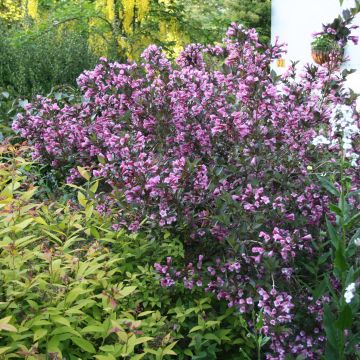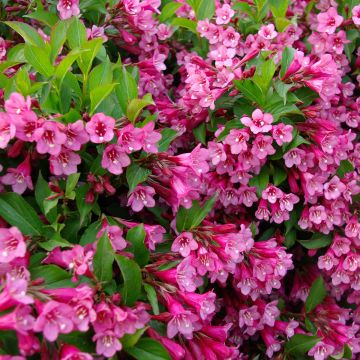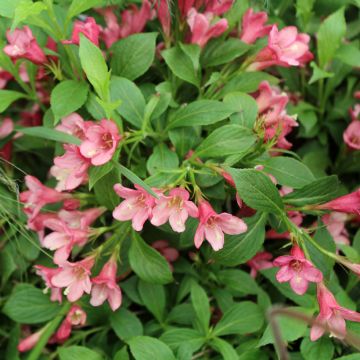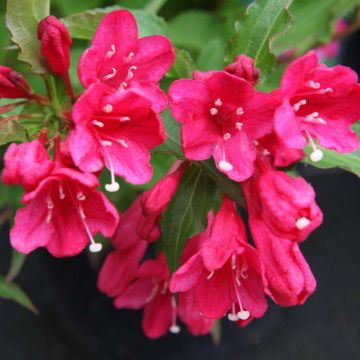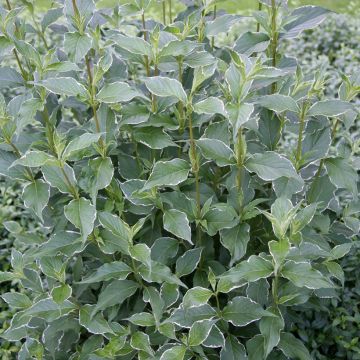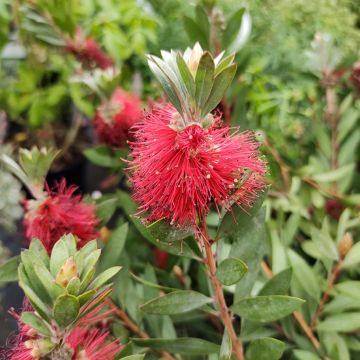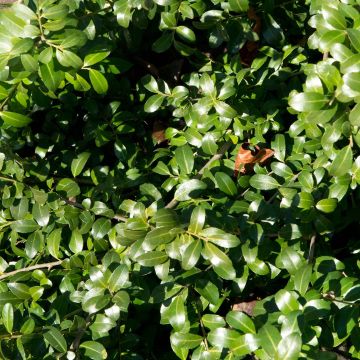

Weigela Milk and Honey ® - Weigélia panaché.


Weigela Milk and Honey ® - Weigélia panaché.


Weigela Milk and Honey ® - Weigélia panaché.


Weigela Milk and Honey ® - Weigélia panaché.
Weigela florida Milk and Honey
Weigela florida Milk and Honey®
Old-fashioned Weigela
In replacement of the variegated dwarf Weigela (which did not recover but is unavailable). Beautiful specimen, well rooted and ramified. Variegated foliage similar to the photo. New stems are a bit soft, giving it a very flexible habit, moving with even the slightest breeze. The flowering was already almost finished upon receipt. Waiting for it to recover.
Nathalie, 04/06/2021
This item cannot be shipped to the selected country
Delivery charge from €5.90
More information
Schedule delivery date,
and select date in basket
This plant carries a 24 months recovery warranty
More information
We guarantee the quality of our plants for a full growing cycle, and will replace at our expense any plant that fails to recover under normal climatic and planting conditions.
From €5.90 for pickup delivery and €6.90 for home delivery
Express home delivery from €8.90.
Does this plant fit my garden?
Set up your Plantfit profile →
Description
Weigela 'Milk and Honey' is a new, bright and refined variety with an upright habit and moderate growth, perfect for bringing life to partially shaded beds, even in small gardens. It charms with its beautifully variegated foliage of yellow and bright green, which turns red and yellow in autumn, as well as its abundant white summer flowering. This elegant shrub can be planted in ordinary but moist soil in a sunny, countryside-inspired or romantic bed, or even in a small flowering hedge or a large pot on the terrace.
Originally from northern China, Japan, and Korea, Weigela florida is a deciduous shrub belonging to the Caprifoliaceae family. This calcicolous (preferring calcareous soils) shrub has a fibrous and spreading root system, which is perfect for transplantation. The 'Milk and Honey' cultivar, from which it originates, has a compact and upright habit and quickly forms a bush 1.5 m (5 ft) tall and 1 m (3 ft) wide. Its funnel-shaped white flowers are produced abundantly. They are borne on corymbs at the ends of the current year's branches and bloom from May to June. Its irregularly variegated light green and yellow foliage is composed of sessile, pubescent, ovate to elliptical leaves that turn a beautiful golden-yellow with red variegation before falling in autumn. The branches of this shrub are arched and have two rows of hairs.
Hardy down to -20 °C (-4 °F), Weigela 'Milk and Honey' thrives in gently sunny or partially shaded positions to protect its foliage from sunburn, in a moist but well-drained soil. Its arching and compact habit makes it a graceful shrub, whose abundant and candid flowering enhances the charm of its variegated foliage. In a bed, for example, you can pair it with Galega, variegated dogwoods, ornamental brambles, or Physocarpus. In the background, the very dark foliage of hollies, boxwoods, or yews will create a dark backdrop for its bright foliage and provide winter appeal. You can also grow this weigela in a pot on the terrace, train it on a small trellis, or plant it in the centre of a bed of nepetas and columbines in a small garden to attract attention.
Report an error about the product description
Weigela florida Milk and Honey in pictures




Plant habit
Flowering
Foliage
Botanical data
Weigela
florida
Milk and Honey®
Caprifoliaceae
Old-fashioned Weigela
Cultivar or hybrid
Other Weigela
Planting and care
Hardy down to -20 °C (-4 °F), Weigela 'Milk and Honey' thrives in gently sunny (morning sun) or semi-shaded positions, away from the scorching sun that would damage its variegated foliage. Plant it in a moist but well-drained ordinary soil, with a neutral to slightly alkaline pH, from October to March (excluding frost periods). To maintain a compact habit and encourage flowering, prune back the branches that have borne spring flowers by 2/3, just after flowering.
Planting period
Intended location
Care
-
, onOrder confirmed
Reply from on Promesse de fleurs
Hedge shrubs
Haven't found what you were looking for?
Hardiness is the lowest winter temperature a plant can endure without suffering serious damage or even dying. However, hardiness is affected by location (a sheltered area, such as a patio), protection (winter cover) and soil type (hardiness is improved by well-drained soil).

Photo Sharing Terms & Conditions
In order to encourage gardeners to interact and share their experiences, Promesse de fleurs offers various media enabling content to be uploaded onto its Site - in particular via the ‘Photo sharing’ module.
The User agrees to refrain from:
- Posting any content that is illegal, prejudicial, insulting, racist, inciteful to hatred, revisionist, contrary to public decency, that infringes on privacy or on the privacy rights of third parties, in particular the publicity rights of persons and goods, intellectual property rights, or the right to privacy.
- Submitting content on behalf of a third party;
- Impersonate the identity of a third party and/or publish any personal information about a third party;
In general, the User undertakes to refrain from any unethical behaviour.
All Content (in particular text, comments, files, images, photos, videos, creative works, etc.), which may be subject to property or intellectual property rights, image or other private rights, shall remain the property of the User, subject to the limited rights granted by the terms of the licence granted by Promesse de fleurs as stated below. Users are at liberty to publish or not to publish such Content on the Site, notably via the ‘Photo Sharing’ facility, and accept that this Content shall be made public and freely accessible, notably on the Internet.
Users further acknowledge, undertake to have ,and guarantee that they hold all necessary rights and permissions to publish such material on the Site, in particular with regard to the legislation in force pertaining to any privacy, property, intellectual property, image, or contractual rights, or rights of any other nature. By publishing such Content on the Site, Users acknowledge accepting full liability as publishers of the Content within the meaning of the law, and grant Promesse de fleurs, free of charge, an inclusive, worldwide licence for the said Content for the entire duration of its publication, including all reproduction, representation, up/downloading, displaying, performing, transmission, and storage rights.
Users also grant permission for their name to be linked to the Content and accept that this link may not always be made available.
By engaging in posting material, Users consent to their Content becoming automatically accessible on the Internet, in particular on other sites and/or blogs and/or web pages of the Promesse de fleurs site, including in particular social pages and the Promesse de fleurs catalogue.
Users may secure the removal of entrusted content free of charge by issuing a simple request via our contact form.
The flowering period indicated on our website applies to countries and regions located in USDA zone 8 (France, the United Kingdom, Ireland, the Netherlands, etc.)
It will vary according to where you live:
- In zones 9 to 10 (Italy, Spain, Greece, etc.), flowering will occur about 2 to 4 weeks earlier.
- In zones 6 to 7 (Germany, Poland, Slovenia, and lower mountainous regions), flowering will be delayed by 2 to 3 weeks.
- In zone 5 (Central Europe, Scandinavia), blooming will be delayed by 3 to 5 weeks.
In temperate climates, pruning of spring-flowering shrubs (forsythia, spireas, etc.) should be done just after flowering.
Pruning of summer-flowering shrubs (Indian Lilac, Perovskia, etc.) can be done in winter or spring.
In cold regions as well as with frost-sensitive plants, avoid pruning too early when severe frosts may still occur.
The planting period indicated on our website applies to countries and regions located in USDA zone 8 (France, United Kingdom, Ireland, Netherlands).
It will vary according to where you live:
- In Mediterranean zones (Marseille, Madrid, Milan, etc.), autumn and winter are the best planting periods.
- In continental zones (Strasbourg, Munich, Vienna, etc.), delay planting by 2 to 3 weeks in spring and bring it forward by 2 to 4 weeks in autumn.
- In mountainous regions (the Alps, Pyrenees, Carpathians, etc.), it is best to plant in late spring (May-June) or late summer (August-September).
The harvesting period indicated on our website applies to countries and regions in USDA zone 8 (France, England, Ireland, the Netherlands).
In colder areas (Scandinavia, Poland, Austria...) fruit and vegetable harvests are likely to be delayed by 3-4 weeks.
In warmer areas (Italy, Spain, Greece, etc.), harvesting will probably take place earlier, depending on weather conditions.
The sowing periods indicated on our website apply to countries and regions within USDA Zone 8 (France, UK, Ireland, Netherlands).
In colder areas (Scandinavia, Poland, Austria...), delay any outdoor sowing by 3-4 weeks, or sow under glass.
In warmer climes (Italy, Spain, Greece, etc.), bring outdoor sowing forward by a few weeks.




































